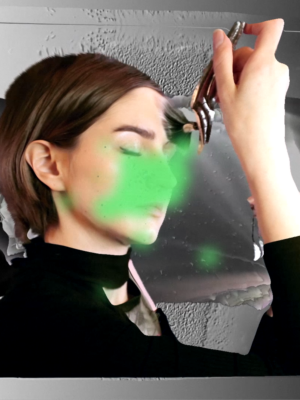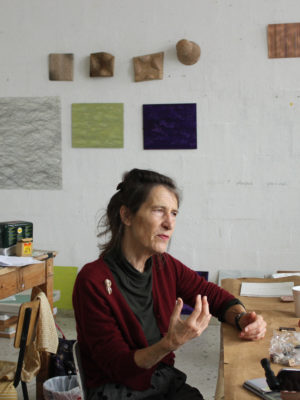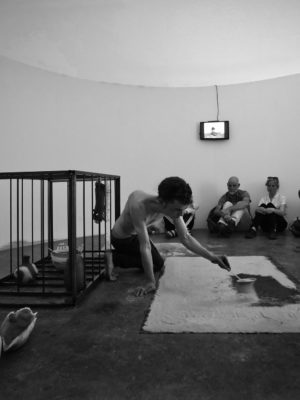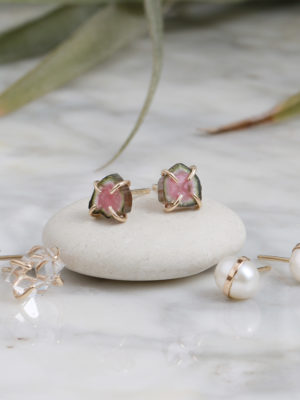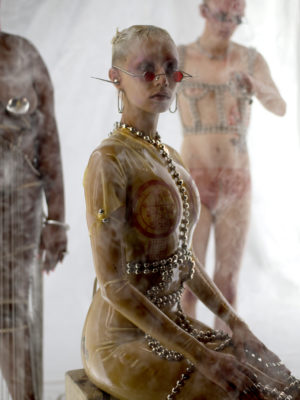New to the term? Though the effects of the ‘Post-Digital’ are largely left out of contemporary craft or jewellery discourse, you can find solace in the fact that you are already, perhaps unbeknownst to yourself, fully living within this realm, exponentially so right now. Some might actually view this physical publication as an antidote to the Post-Digital, but as a matter of fact, it is simultaneously a consequence of it as well. If that sounds confusing, think less postmodernism and more post-punk (still having the essence of punk ‘yet also beyond punk’), or even post-colonial (which in no way signifies that colonialism is over), and then apply that logic to the concept of something ‘digital’ — a word which now means many things, with definitions that can seem contradictory. (2) For the sake of ease, go with whatever your immediate connotations of the word end up being, and then remember that we are living within a time where all digital disruptions have most likely come to pass.
Jewellery practice is no exception to these reverberations. The world now is hyper-connective, open source and user-generated. This includes the new ways of making, seeing, and interfacing with Contemporary Jewellery, which has only accelerated within the course of the last twelve months (thank you, Corona). This piece is a snapshot of our current moment in time, where form has become content, jewellery has a bigger place within the economy of images, and burgeoning virtual exhibition formats might be the next big thing for the field, global pandemic or not.
Burnham’s prediction resonates now more than ever. Whether in embrace or trepidation of technology, today’s connectivity informs new meanings around our relationship to objects, and also informs what they are allowed to become. Looked at from a certain vantage point, we are entering an era that returns to the object, though in a way, more intangibly: craft is becoming 21st century content.
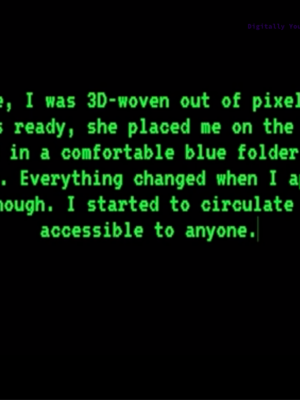
When is an Instagram post more than an Instagram post? As with most other Millennials, Estonian jewellery artist Darja Popolitova is a Digital Native, who ___STEADY_PAYWALL___ grew up with the inherent infrastructure of the internet. For this generation, it is easy to take for granted the ways 3D objects are largely seen and experienced today: on devices, where newer, hybridized craft practices like hers thrive. They exist as the primary place of encounter for her work. This is exemplified by her Instagram account. Of significance are: a mix of the artist’s amorphous, alien-esque jewellery pieces a) either on a white background, the standard ‘professional’ convention; b) installed in an exhibition setting; c) featured as a still from one of her video pieces; d) as a digital process shot before its material manifestation takes place; e) in her hand or on her body, most likely in the form a selfie; f) or some combination of it all. In the last few scenarios, the background of the photos are often digitally doctored. She also sometimes presents herself in wigs, iridescent makeup and/or with face filters alluding to some kind of virtual alter-ego. With titles like Narcissus, Anti Clicking Spike and Digital Detox Brush, she is making work that ‘addresses the digital condition… a condition of artworks and objects that are conceptually and practically shaped by the internet and digital processes, yet often manifest in the material form. (3)
Though the physical jewellery objects are the crux of what Popolitova creates, they are also just a part of the total picture, or the collective persona she presents when she shares that jewellery online. The combination of physical and digital adornment – which the processes of creating are increasingly less distinguishable. – plus the generation of intriguing accompanying texts (otherwise known as captions, though I think hers are more than that), is what formalizes and gives space to the physical objects that emerge from her studio. The totality of her output, that which we find on Instagram, is more than content. As a whole, a certain post becomes something singular, more than the sum of its parts: each output is a Digital Gesamtkunstwerk, or ‘total work of art’.
The information and experiences that make up her particular content is imperative to the reading of the physical pieces of which they play a part. There are others like her: Simon Margsiglia, Ada Chen, and Kalkidan Hoex come to mind; where the framework of their pieces is the makers’ projected identity through the digital image. Contemporary Jewellery is only now beginning to blossom in this space and play with self-insertion into pop culture and today’s image economy. It’s an interesting discourse that allows us to evaluate object meta-versioning, and question shifting value of physical objects when compaired to their online iterations.
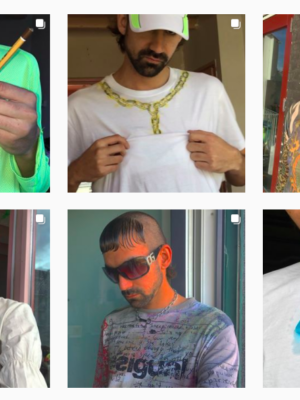
‘There is something fascinating about ‘an object slipping into a meta-state as its primary state… only validated by its meta-version.’
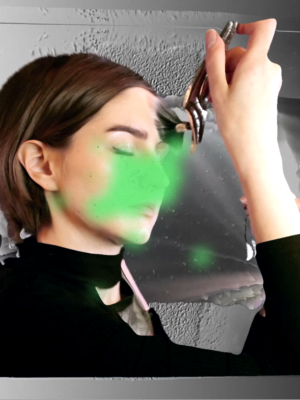
The internet is filled indiscriminately with images; from high-resolution photos to ‘poor images’ — ‘an illicit fifth-generation bastard of an original image’, as artist and filmmaker Hito Steyerl calls them. (4) Combine that with the advent of social media and the birth of the ‘me me me’ generation post-Y2K, and it is no wonder that the work of Popolitova exists today, that digital narcissism is a trait of Gen Y and those that follow. Today’s Post-Digital Era is built on extreme reference culture accelerated by an infinite remix of images of things based on preexisting images of things. They find new meaning, and arguably become singular things in and of themselves. Memes are a succinct example of this experiential process; some of which could even be considered as virtual found objects. As more of our physical reality syncs up with our screens, will our value system for physical objects change? Will we want more IRL time with them, or less? Will our appreciation for tactile materiality go up or down? And what will that mean in the post-pandemic era, which is now being defined by a reality almost entirely devoid of physicality, only linked to our screens? Does it even matter?
There is something fascinating about ‘an object slipping into a meta-state as its primary state… only validated by its meta-version,’ as design historian Glenn Adamson puts it: ‘is it going to be the photograph of the thing that is the actual thing?’. (5) He ponders the idea of ‘intellectual property as the core unit of exchange rather than the object – it’s basically where creativity and capital overlap in the purest form, so that makes you think that were entering a circulatory system where content and form may themselves be colliding.’ In the case of the Digital Gesamtkunstwerk, this is all absolutely true. These thoughts call to question the idea of authenticity of object or space and shifting notions of aura.
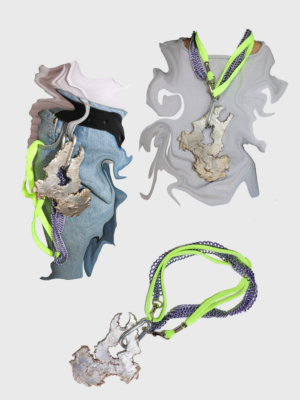
At the risk of using an old cliché, Walter Benjamin said that ‘the presence of the original is the prerequisite to the concept of authenticity.’ But what about in cyberspace? When considering the object as just one element of Digital Gesamtkunstwerk, or even simply depicted on a white background and found online, can that theory still be applied? Is it a moot point? A timelier lens through which to see and understand evolving spaces for jewellery is the condition of ‘technophoria… a new metabolic state devised by late capitalism whereby human needs and desires are purely satiated by the continual evolution of their electronic devices.’ This statement comes from curator, writer and cultural historian Dr. Omar Kholeif, who rightfully points out John Berger’s extensions of Benjamin’s theory (will we ever be done with these guys?) in regards to the influences of pop culture and marketing on image (re)production: ‘the intent of the subject—to be idolized, to be envied—as integral to a work of art as the intent of the artist.’ (7) In short, Instagram is fulfilling Berger’s prophecy to the Nth degree.
Kholeif says we have now evolved into a state where we ‘no longer just examine an image, we metabolize it…’; stating that the ‘agency’ of aura must be reexamined, because ‘the traditional notions of art — its spatiality, its tactileness, its dimensionality, its authenticity — are no longer the dominating attributes in how we look at visual work.’ (8) This is true even for jewellery, which more than other kinds of art and design objects relies on materiality and tactility to be appreciated. For the most part, actors in the field have traditionally maintained the position that aura is truly struck in the moment that a person feels compelled to put on piece of jewellery, to be one with it, but is that really the case anymore? Perhaps jewellery’s new authentic space is actually the internet where new aristic work now comes in multiple digital iterations. Who, therefore, is to say which version of Popolitova’s jewels, for example, is more authentic than another? When a piece’s hyperrealness looks better zoomed in and gleaming from the screen of a smartphone than it might in physical reality, is that its aura radiating before our eyes? I would argue that phone viewing actually benefits certain pieces of jewellery from being seen that way, especially in comparison to an encounter behind a plexi vitrine.
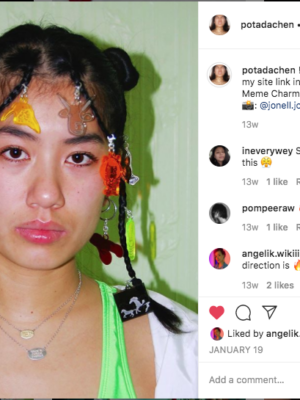
I first came to this subject of the Post-Digital within the realm of jewellery as it relates to how this new ‘output’ can and should be considered by curatorial minds, particularly museum curators. My interest was more about the outcome versus the equally interesting Post-Digital making practices that go into a physical object’s creation, such as using 3D technologies in lieu of more traditional approaches (so many good artists explore in this regard, like Annika Pettersson or Adam Grinovich). The museum has been known to be the primary place of artistic validation, reaffirmation, and archive, yet as they scramble to optimize virtual viewing experiences for the objects in their care (which of course has been thrust upon them by the pandemic), we can look to artists for some of the best examples of online-only exhibition based frameworks, spaces that acknowledge and celebrate the Post-Digital experiences of which we are exploring. Certain projects also reaffirm the endlessly adaptable creativity of jewellers, who have long been successful multi-hyphenates: photographers, graphic designers, small business owners, social media managers, and of course, curators.
Recently I spoke with Steven (KP) Kaplan-Pistiner, art jeweller and co-curator (alongside Jessica Andersen) of the online exhibition Digitally Yours made specifically for the virtual rendition of New York City Jewelry Week 2020. Initially I was surprised to see this project come from two very materially driven artists. KP hand-carves knotted brooches from wood, and Jessica remains invested in the lives of material things and reclamation; they both share love for the ‘vibrancy of material, actually holding it and feeling it, wearing it.’ (9) At the same time though, the duo acknowledged that this wasn’t going to be an option all the time, especially in the face of the pandemic. They wanted to showcase artists tackling ideas of connection, isolation and intimacy that would suit a virtual and interactive environment –one that explores ‘the relationship between digital realms, image, communication, participation, and jewellery.’ (10)
Popolitova was the first to be named during our chat, her open source project of downloadable files (called Save As) being a pristine display of both the freedom and flexibility of system-based internet activity, and a level of personalization so closely tied to the medium of jewellery. ‘We have things in our exhibition that do not exist anymore because those files are ever changing, which I think is really interesting in the context of jewellery as a project, but also as a thing to preserve in museums. Every time someone prints or loads up one of her files, they alter. It’s a really beautiful way of making sure that each time the screen is loaded, it’s a really valuable and impactful moment.’ (11)
Leslie Shershow’s Jewellery Generator is even more poignant. On the Digitally Yours site, one is led to a customizable menu where the participant is able to recall a specific memory of their choosing, then manifest and memorialize it into an automated but unique piece of jewellery that can be ordered, or discarded. The interactive works by Brice Garret also deserve a mention: a user can access a webpage where through the click and drag of the mouse, silhouetted forms derived from jewels found online can be rearranged to the user’s liking. Even though this show was born from the call of the pandemic to harness new modes of meaningful connection, KP says the project in general ‘really got me thinking about how we cultivate relationships, and how even if the digital isn’t the material you’re working in, it is the setting that we are all occupying. It’s more than making sure you’re seen.’ (12)
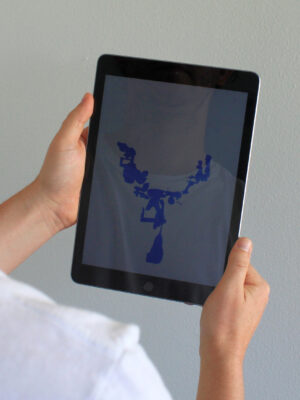
‘To me it is clear that Contemporary Jewellers have long been talented form givers beyond the making of their individual jewellery pieces.’
So what’s the difference between something posted and something published, or exhibited? I actually do not think these kind of distinctions matter so much, or render certain output more or less interesting. But the curators seemed well aware of such nuance, and consequently took care to give singular form to this project through the letter-writing component of the show. At the start of each artist’s page, there is a text-based audio/video of each artist reading a letter that welcomes and introduces their contributions, beautifully facilitating a private moment between artist and viewer. It’s something one rarely gets at a physical exhibition opening, not to mention recalls the nostalgia for early internet chat rooms, one of the defining freedoms of the digital revolution.
One might ask if the projects made for Digitally Yours, and the exhibition as a singular entity for that matter, is art or mere documentation. I don’t think it matters. There is one more notable benefit to such virtual projects, other than calling on object makers to optimize their creations for a more complex and future looking level of engagement: they create time capsules, sure, but more importantly, they are important archives for the field of Contemporary Jewellery made in real-time, an opportunity still too far beyond the periphery of museums. It is my long held belief that exhibitions are the field’s primary (albeit inadvertent) tool for generating scholarship and a critical theory of the field itself, and projects like Digitally Yours are a genre-defining example.
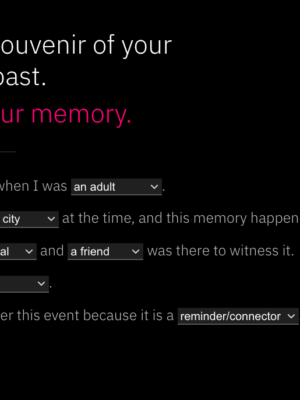
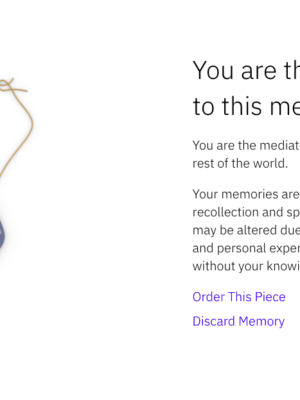
To me it is clear that Contemporary Jewellers have long been talented form givers beyond the making of their individual jewellery pieces. Whether it is through an artist run exhibition, or via the creation of virtual framework adapted for online only viewing, more and more they are the masters of their entire domain. Media theorist Boris Gorys discusses it best: form givers are becoming contentproviders, meanwhile curators are the new, traditional form givers, tasked with achieving singular form through curatorial projects both online and off.5 Some are better at it than others, but jewellers do both, and I believe are surprising protagonists of Post-Digital attitudes.
If there’s one take away to this text, maybe it is simply that jewellers are more than capable of participating in the Post-Digital conversation, a topic I’ve been researching long before the pandemic showed its face (mask, please!). Perhaps it pushed our field into that direction a bit more abruptly than if we had set the pace ourselves, but we are more than rising to the occasion: as a compliment to physical viewing opportunities, never a substitute, Contemporary Jewellery is an inherently Post-Digital medium, primed for the hybrid virtual stage.
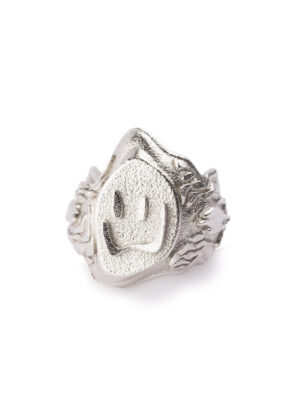
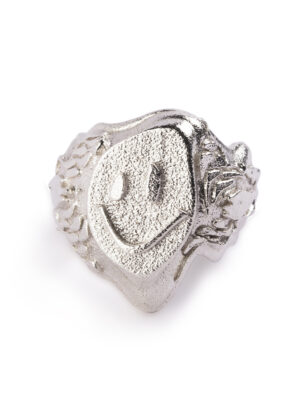
This text is an extremely reduced adaptation of Kellie’s 2020 MA thesis entitled, ’A Remarkable Lacuna: The Post-Digital Gap In Museum Curating For Contemporary Jewelry.‘
1 Jack Burnham, “System Esthetics”, Artforum, VOL. 7, NO. 1 (September 1968), 31.
2 Florian Cramer, “What is ‘Post-Digital’?, in Postdigital Aesthetics- Art, Computation and Design, United Kingdom: Palgrave Macmillan, 2015, 14-15.
3 Christiane Paul, “Museums in the Post-Digital Past and Future: Materials, Mediation, Models” in Museums at the Post-Digital Turn, Milan: Moussee Publishing, 2019, 143.
4 Hito Steyerl, “In Defense of the Poor Image”, e-flux, Journal #10, November 2009, https://www.e-flux.com/journal/10/61362/in-defense-of-the-poor-image/
5 Glenn Adamson, in-person interview, December 11, 2019.
6 Omar Kholeif, Goodbye, World! Looking at Art in the Digital Age, Sternberg Press: Berlin, 2018, 89.
7 Kholeif, Goodbye, World!, 101-102.
8 Ibid., 173-174.
9 Steven Kaplan-Pristiner, Zoom interview, February 19, 2021.
10 Steven Kaplan-Pristiner and Jessica Andersen, https://digitallyyoursexhibition.com/about/
11 Kaplan-Pristiner, interview.
12 Ibid.
13 Groys, “From the Form-Giver to the Content-Provider”, 38-46.
Kellie Riggs (b.1986, USA) is a writer, critic and curator with a focus on Contemporary Jewelry, and sometimes jeweller. She received her BFA in Jewelry + Metalsmithing at the Rhode Island School of Design in 2011, and upon graduating received a Fulbright Grant to Italy, where she has remained on and off ever since. She has been an external editor at, Current Obsession, with whom she also cocurated the exhibition CULT at the Design Museum den Bosch in 2016. Kellie experienced her solo-curatorial debut with the exhibition, Non-Stick Nostalgia: Y2K Retrofuturism in Contemporary Jewelry at the Museum of Arts and Design in Spring 2019. In May 2020 she also earned a Masters in Visual Art Administration at New York University.
